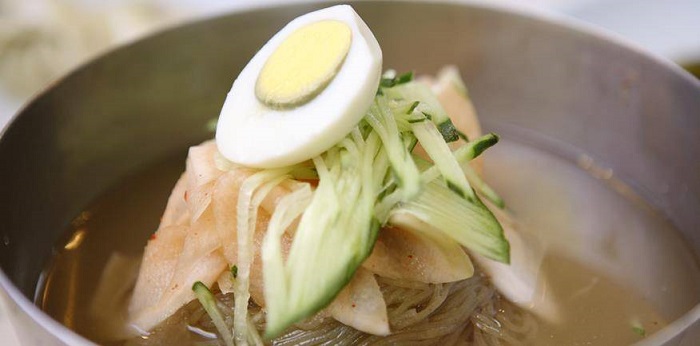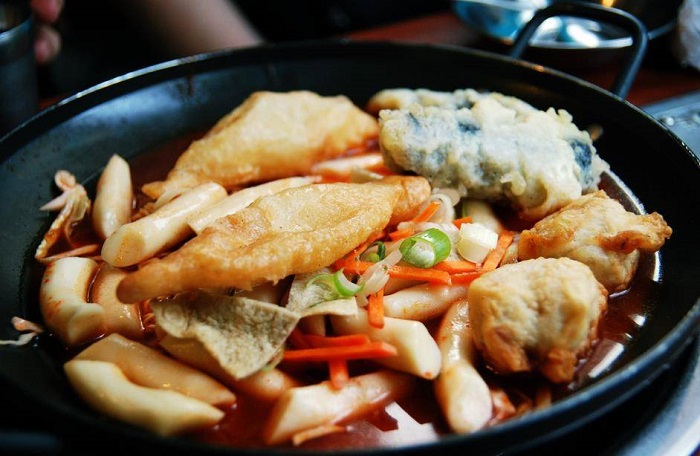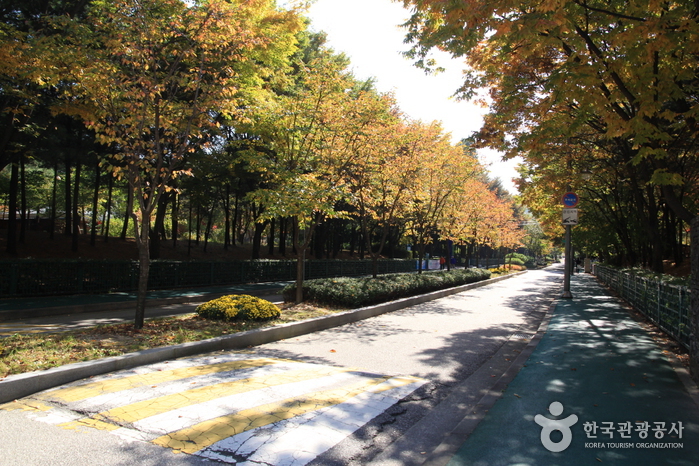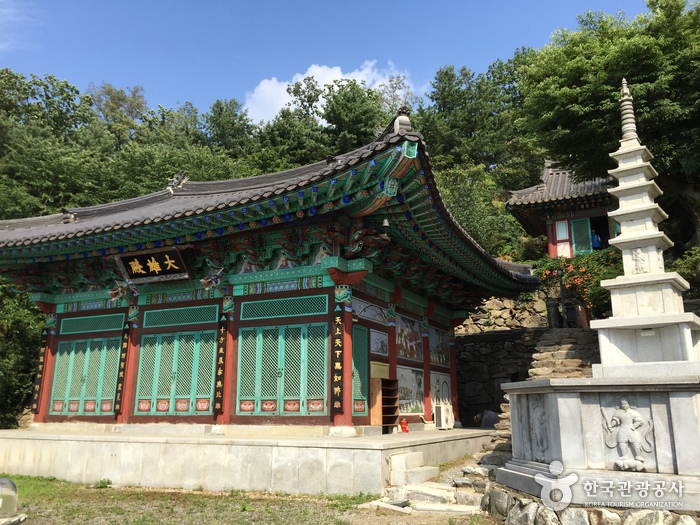Banktree Garden (은행나무가든)
19.5 Km 18838 2024-02-27
212-5 Chungnyeongsan-ro, Sudong-myeon, Namyangju-si, Gyeonggi-do
031-553-8200
Banktree Garden, a meat specialty restaurant in Namyangju, offers a variety of meat dishes including pork, chicken, and duck. Their signature dishes are hwangto gama samgyeopsal (clay-baked pork belly), which is pork belly grilled in an clay kiln, and neungi ori hanbang baeksuk (whole duck soup with shingled hedgehog and medicinal herbs), a slow-cooked duck dish prepared in a broth infused with fifteen different medicinal herbs.
Homeplus - Namyangju Jinjeop Branch [Tax Refund Shop] (홈플러스 남양주진접)
19.5 Km 0 2024-04-23
1447, Geumgang-ro, Jinjeop-eup, Namyangju-si, Gyeonggi-do
-
Seobungmyeonok (서북면옥)
19.5 Km 4816 2021-04-20
199-1, Jayang-ro, Gwangjin-gu, Seoul
+82-2-457-8319
It is a 100-year-old store that has been loved by customers for a long time while maintaining its reputation for over 30 years. This Korean dishes restaurant is located in Gwangjin-gu, Seoul. The representative menu is cold buckwheat noodles.
Olive Young - Namyangju Janghyeon Branch [Tax Refund Shop] (올리브영 남양주장현점)
19.5 Km 0 2024-06-26
77, Janghyeon-ro, Jinjeop-eup, Namyangju-si, Gyeonggi-do
-
Hwarangdae Railroad Park (화랑대 철도공원)
19.5 Km 2 2023-08-11
Gongneung-dong, Nowon-gu, Seoul
Hwarangdae Railroad Park is a 400-meter-long light park featuring 10 different themed courses with various lit sculptures. It was renovated from abandoned Hwarangdae Station. Visitors can see ann exhbition of real trains that operated in the past and enjoy a cup of coffee at the train cafe.
Taereung and Gangneung Royal Tombs [UNESCO World Heritage] (서울 태릉과 강릉 [유네스코 세계문화유산])
19.6 Km 26105 2022-09-19
681, Hwarang-ro, Nowon-gu, Seoul
+82-2-972-0370
Designated as a Historic Site, Taereung & Gangneung Royal Tombs is comprised of two tombs. Taereung Royal Tomb houses the burial mound of Queen Munjeong who was the second queen of King Jungjong, the 11th King of the Joseon dynasty, and Gangneung Royal Tomb houses the burial mounds of King Myeongjong, the 13th King of Joseon dynasty, and Queen Insun. King Myeongjong ascended the throne after his elder brother, King Injong, when he was twelve years old at Geunjeongjeon Hall in Gyeongbokgung Palace in 1545. The king’s mother, Queen Munjeong ruled behind the scenes, acting as guardian for eight years.
Modurang (모두랑)
19.6 Km 54 2021-03-29
24, Jayang-ro 28-gil, Gwangjin-gu, Seoul
+82-2-457-1178
You can enjoy Tteokbokki, Korea's representative street food. This Korean dishes restaurant is located in Gwangjin-gu, Seoul. The representative menu is stir-fried rice cake.
Bonghwasan Mountain - Seoul (봉화산 (서울))
19.6 Km 16306 2022-09-14
Sinnae-ro 21-gil, Jungnang-gu, Seoul
+82-2-2094-2353
Bonghwasan Mountain (alt. 160 meters) in Jungnang-gu, Seoul offers scenic views of Buramsan, Dobongsan, and Namsan mountains. From the mountain, hikers can even see as far as the Yangju area of Gyeonggi-do Province to the north. Officially designated a “neighborhood park” in July 1977, Bonghwasan Mountain has a variety of convenience facilities, not least of which is the beacon tower of Achasan Bongsudae (remolded in 1994) perched on the mountain summit. Also near the summit is Sansingak Shrine, which is the site of the annual Bonghwasan Dodanggut (Intangible Cultural Property of Seoul), a shamanistic rite performed on the third day of the third lunar month.
Manggyeongam Hermitage (망경암)
19.7 Km 25011 2021-04-24
72, Taepyeong-ro 55beon-gil, Sujeong-gu, Seongnam-si, Gyeonggi-do
+82-31-753-3090
Manggyeongam’s name derives from the hermitage's view of Seoul, and is located in Bokjeong-dong of Seongnam, Gyeonggi-do. Manggyeongam
Hermitage is said to be the place where kings of the late Goryeo and early Joseon periods prayed for peace for their subjects. In addition, Prince Pyeongwon, the 7th son of King Sejong, and Grand Prince Jean built an altar at Mangyeongam Hermitage and Chilseongdae Peak and pledged filial piety.
The hermitage is more widely known for its connection to the Chilseong faith, in which believers worship
Chilseong (the Seven Stars). It is easily recognized by the written records inscribed into the rock wall. Located at the hermitage is the Rock-carved Seated Buddha, an original work of the hermitage that is also designated Gyeonggi-do’s Tangible Cultural Asset No. 102. The Buddha is embossed inside a deep hole in the rock. In the words inscribed near the statue, there is also a legend that says Lee Gu-seung carved Gwaneum Statue near Rock-carved Seated Buddha and built the hermitage in 1897.
Next to the hermitage is a pond called “Bokumul,”
which means “blessed sugared water.” The neighborhood of Bojeong-dong takes its name from this pond. At the hermitage, Daeungjeon Hall (the main hall), Samseonggak Shrine (shrine for three spirits), and Mireukjeon Hall were all established fairly recently. The hermitage site also includes a huge Mireuk Daebul statue (Great State of Maitreya Buddha) and a five-story stone pagoda.
The Garden of Morning Calm (아침고요수목원)
19.7 Km 425297 2024-02-15
432 Sumogwon-ro, Sang-myeon, Gapyeong-gun, Gyeonggi-do
+82-1544-6703
The Garden of Morning Calm, nestled against the splendid backdrop of Chungnyeongsan Mountain, is a horticultural haven that blends the essence of Korean beauty with a diversity of themed gardens. Designed by Professor Han Sang-kyeong from Sahmyook University, this arboretum, which opened in May 1996, offers a tranquil retreat with forest paths and a dense pine nut grove for those escaping the bustle of the city. Its twenty thematic gardens are interwoven with well-kept grassy expanses, vibrant flower displays, and inviting nature trails. Among these, the Sunken Garden stands out, artfully representing the Korean Peninsula and its stunning landscapes using a rich array of blooming flowers, capturing the admiration of those who visit. Beyond this, the arboretum is home to an impressive collection of plant life, featuring more than 5,000 different species, including more than 300 varieties native to Baekdusan Mountain.


![Taereung and Gangneung Royal Tombs [UNESCO World Heritage] (서울 태릉과 강릉 [유네스코 세계문화유산])](http://tong.visitkorea.or.kr/cms/resource/16/2658216_image2_1.jpg)



 English
English
 한국어
한국어 日本語
日本語 中文(简体)
中文(简体) Deutsch
Deutsch Français
Français Español
Español Русский
Русский